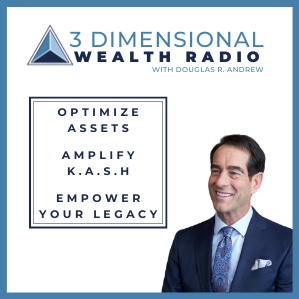What’s Wrong with IRAs and 401(k)s?
This question might have already crossed your mind as you’re watching the economic fallout of the COVID-19 crisis. The stock market is on a wild roller coaster ride almost on the daily. Many Americans are losing significant portions of their 401(k) and IRA value as we speak.
I’ve been a financial strategist for more than 45 years, and I’ve never owned an IRA or 401(k), never will.
Why?
I’ll explain the basics of both traditional retirement vehicles, then I’ll let you in on what Uncle Sam doesn’t want you to think about … that 401(k)s and IRAs have some drawbacks, and they shouldn’t be your only approach to saving for your future.
You might also be thinking , “But Doug, EVERYONE uses 401(k)s and IRAs, so everyone can’t be wrong.” Yes, I’ll concur that millions of Americans use 401(k)s and IRAs to set aside money for retirement. And 401(k)s and IRAS aren’t all that bad—they can play a significant role in your overall retirement portfolio.
Let’s just say, don’t put all your eggs in that basket when you’re looking at growing your retirement nest egg.
THE BASICS – 401(k)s
401(k)s were established by the government back in the 70s with the Revenue Act of 1978. (That could be your first clue that it’s not all roses—would Uncle Sam do anything that DOESN’T benefit himself?) The act added an Internal Revenue Code—Section 401(k)—that essentially made it possible for employees to set aside pre-tax dollars for retirement.
Here’s how it works: You put a percentage of each paycheck’s pre-tax dollars in the 401(k) account; your employer often matches each contribution up to a certain percentage, typically 3% or 4%. Currently you can contribute up to $19,500 a year in your 401(k), or up to $26,000 if you’re 50 or older (since this can change year-to-year, search for the latest contribution limits at IRS News Releases).
Your account is invested in the stock market, typically in your choice of funds offered by your employer’s financial services provider. When the stock market goes up, your account balance grows. When the stock market goes down, your account balance shrinks. Your money plays the stock market game until at least age 59 ½, when you can start withdrawing money from the account.
(As a side note, you can withdraw money earlier, but you’ll face a penalty fee and taxes. You can also wait longer, but starting in your early 70s, you have to start taking Required Minimum Withdrawals or face penalty fees—for more info on RMDs, see IRS RMD FAQs.)
As you withdraw money, you’re taxed on the back-end growth on the funds you take out.
THE BASICS – IRAs
Born with the Retirement Income Security Act of 1974, IRAs have similarities to 401(k)s. Your IRA account is also at play in the stock market. You can begin withdrawing money at age 59 ½ and you’re taxed on the money you take out with each withdrawal. (You’ll face similar penalties and taxes as the 401(k) for early withdrawal, and similar RMDs in your early 70s, see the IRS RMD FAQs for more info).
With an IRA, your tax breaks also happen on the front end, as you can contribute pre-tax dollars. Generally, your contributions are also tax-deductible in the year they are made; however those tax deductions can be limited if you or your spouse also has a workplace savings plan like a 401(k).
There are some notable differences between IRAs and 401(k)s. For one, you’re on your own in the contribution phase—there is no employer participation. And there are much lower annual contribution limits: currently it’s $6,000 a year, or up to $7,000 if you’re 50 or older (for the latest contribution limits, search IRS News Releases).
PAYING TAXES ON THE SEED OR THE HARVEST?
Let’s digress for a moment to look at an analogy that will help you compare retirement vehicles. Imagine you’re a farmer. Winter is about to give way to spring’s warmer days, and you’re getting ready to prepare your fields for the growing season.
As you look out across your acres, you can picture the seedlings that will take root. You can see summer’s sun radiating life into your emerging crops. You can even look ahead to the fall, when you’ll be harvesting your bounty.
Here’s a question for you: When would you rather be taxed?
Would you rather pay taxes on the front end, when you purchase your seed?
Or would you like to wait until the harvest, when you’re selling your crops?
Now apply this same question to the issue of financial planning. Would you rather pay taxes on your earnings before you “plant” them in a financial vehicle to give them a chance to grow? Or would you prefer to pay taxes on your “harvest,” when you go to withdraw money for retirement or other ventures?
THE TAX REALITY – 401(k)s and IRAs
By opting for a 401(k) or IRA, most Americans choose the harvest.
They listen to traditional advice and follow the crowd—often without realizing there’s any other way to do it. They put their pre-tax dollars into their IRA, thinking it’s better to put as much as they can into the account during the contribution phase . Then when they get to the distribution phase [same link]and access their money after age 59½, they pay taxes on those withdrawals.
That’s when most Americans find a shocking surprise: They’re often in a tax bracket that’s as high or higher than during their earning years. That’s largely due to what I call the Reduction Deduction (later in life you tend to have fewer tax deductions for things like children, business expenses, retirement plan contributions, etc.).
Now they’re taking the full brunt of those taxes on their distributions at a time in life when they need the income the most. They’re enjoying less of a harvest than they anticipated. And they’re often worried the pantry will run dry before it’s time.
This is why we would rather see you pay taxes on the seed rather than the harvest on a portion of your retirement portfolio, in order to be tax diversified. That said, 401(k)s and IRAs can play a valuable role in a diversified approach to retirement. Especially with employer contributions on your 401(k), it makes sense to take advantage of the opportunity to set aside some money toward retirement in your 401(k).
Keep in mind, there are other, powerful retirement vehicles to add to your diversified approach that can help you get to the retirement finish line even faster and with greater tax advantages (like the LASER Fund, which I describe in other articles and my book, The LASER Fund).
And with all that’s going on in the world, there might not be a better time than now to get started.
Are you ready to see the nuts and bolts of a LASER Fund? Get your FREE copy of Doug’s book, The LASER Fund. You’ll learn how to protect your “serious cash” and how to eliminate taxes on your retirement nest egg.
Disclaimer: With any mention of The LASER Fund, maximum-funded tax-advantaged insurance contracts, or related financial vehicles, let it be noted that life insurance policies are not investments and, accordingly, should not be purchased as an investment. The content contained in this post is intended for general informational purposes only and is not meant to constitute legal, tax, accounting or investment advice. You should consult a qualified legal or tax professional regarding your specific situation. Many traditional retirement vehicles involve risk, and the value of your investment will fluctuate over time and you may gain or lose money.


